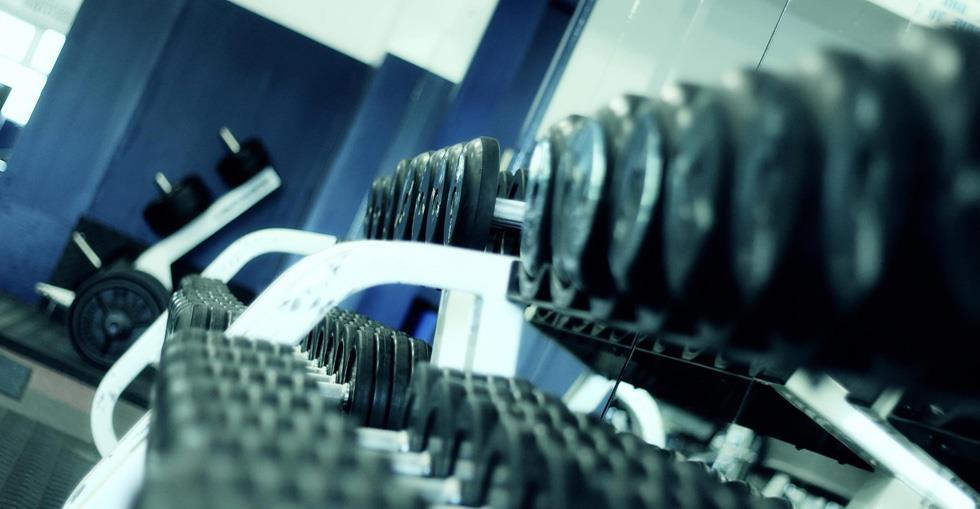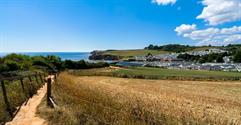It always puzzles me - in the nicest way possible - how someone as sylph-like as Wendy Watkins can possess so much muscle.
She can run faster than me, so I'll be careful about divulging her age... but its compliment enough to her to mention that she entered her first figure competition at the age of 45. And very stunning she looked, too.
Wendy is co-owner of the Bangor Brewer Athletic Club which resides on Abbott Street, Maine, USA. Her business partner, Sean Soucy, is an ex-marine and himself a seasoned bodybuilder.
"Obesity, heart disease, cancer, depression and all sorts of not-so-wonderful stuff grows on my family tree, " Wendy divulges. "Seeing my father die of heart disease at the age of 49, and taking care of my mum as she battled lung cancer taught me a few very important lessons."
Among all this family tragedy, Wendy had always been interested in working out, initially with actress Jane Fonda's legendary exercise videos back in the days of VHS. "I was a writer for a number of years, and eventually specialised in fitness and health, and decided to get a personal training certification to help beef up my credentials.
"Gradually I ended up spending more time personal training than writing, and voila! - here I am!" Not bad for a girl who was a gym-class dropout at school.
For all their risk, gyms can reap rewards even more solid than the inevitable shapely calves
Gyms can be an extremely risky business, but Wendy and Sean are making sure that the Bangor Brewer facility is in excellent form. They - and others - have shared their experiences with me, and hopefully, I'll be able to give you a helpful overview should you be harbouring an interest in owning a gym.
If you're completely clueless (and I recommend working in a gym for at least a couple of months before making any definite move to buy a gym), buying a gym franchise might be the way to go. If you're in a franchise situation, bear in mind that you might have to pay an up-front fee (a minimum of £20,000) as well as ongoing residuals (a minimum of £10,000 per year) to the franchisor, so at the start be mindful also of extra legal expenses to ensure that you are entering an agreement that is not potentially damaging to you.
Funding
What follows is based on the assumption that you have decided to eschew buying into a franchise, and that you are going into business as an independent. "Just a tip," says one gym owner I spoke with. "Get possible funding lined up; don't waste any energy on anything else. Nothing - location, size, alternative revenue streams, management - matters if you can't get funding."
And this is where you have to weigh up your options. Do you go it alone, or do you have more clout with a business partner?
For Wendy Watkins, the second option was the one that worked. "We just got a loan from the bank. Basically, we wrote a business plan, made a list of the equipment of the gym we were interested in buying, and the bank backed us."
I was curious about having credibility with the bank. I asked Wendy if she knew of anyone who ran a gym without actively being involved or teaching there. "I don't!" was her unequivocal reply.
The owner of my own local gym was assisted in its acquisition by his parents, both of whom are now employed on a part-time basis at the operation. But for most people, money will come from a bank or a finance house.
Your business plan should be between 10 and 20 pages long, and contain the following sections: business description, mission statement, market and industry, products and services, features, unique selling points, competition, target clientele, marketing and advertising.
"The rich are deformed by their wealth," the actress Catherine Deneuve once stated. "They never think about the real worth of a project, just its profitability."
But if you're going to win over the bank... and go on to succeed with your fitness venture... you're going to have to think about profit, profit, profit, and demonstrate in your business plan how you are going to get it.
An invaluable aid in your preparatory armoury is the book 'The Business of Fitness: Understanding the Financial Side of Owning a Fitness Business'. This paperback is by Thomas Plummer, and retails for around £20. Mr Plummer has almost 30 years' experience in the fitness field, and he enjoys many five-star reviews of his book on Amazon (to name but one online retailer).
For all their risk, gyms can reap rewards even more solid than the inevitable shapely calves. An Australian-born businessman entered a joint venture with UK chain Fitness First before making his debut on the Australian market in 2001. They bought the 11-gym Healthland chain from liquidators, and by 2005 owned 41 gyms in Australia and over 400 globally.
The Chelsea Harbour Club-once frequented by the late Diana, Princess of Wales, was sold in 1998 for £22m, with memberships at that time costing almost £3,000 per year.
You can make a lot of money in gyms - particularly if you are not underfinanced to begin with. It isn't cheap to enter the gym business (and some de-motivated and overcharged clients with handcuff memberships might say it's the same at their end, too!), so be ambitious and upbeat when you write your plan.
The business plan should contain about a dozen different scenarios playing out over several years.
Don't be overly optimistic. If you think you might get 400 customers in your first year, put down 300 on your business plan. Delight yourself by breaking targets, not by setting unrealistic ones.
Location
Okay. Feedback from the bank is looking good. It's time to find your premises.
Expect to pay anything from £25,000 for a leasehold fitness suite for ladies in Lancashire, to £1,750,000 for the lease of a facility employing 16 people in Cambridgeshire. (The rent alone for that particularly well-equipped operation is £175,000 per year.)
A mid-range facility in the UK can expect to go for about £100,000 leasehold. Between 10,000 and 20,000 square feet (inclusive of changing rooms and office space) is a modest but decent start in terms of size. (You can survive with something smaller if you are going to be, say, a women's-only aerobics studio.)
Look for a neighbourhood with no gyms, or a poor-quality gym. Being near a mall is good. Being near a college is good. You get the picture.
If you are torn between a white collar neighbourhood and a blue collar area, then go for the white collar. The first group need you more, because the blue collar group is active at work. A mix of both demographics is best, though.
When buying an existent gym, don't fall into the vendor's trap of basing the sale price on how much the equipment cost him or her. You should base any offer that you make on customer base, turnover, profit margins and overheads.
If you're expecting to develop the gym from scratch, or to radically overhaul its interior, one option is to go onto local council planning websites. These now carry publicly accessible plans that are downloadable.
It won't take you long to amass a nice cluster of other entrepreneurs' plans, from which you might develop your own ideas. (Selective disclosure is a business art, but we have our ways around it, don't we, readers?)
Visit other gyms in your area, and make a note of what you do and (more importantly) what you don't like about them.
Software
You are going to need software to run your gym, if there isn't any in place already. Many software companies offer the software on a pay-as-you-go/leasing basis, but if you're adept at configuring Microsoft Access, you might just want to create your own gym and client management system. If you are going to go for something commercial, though, do shop around.
Decide early on what the feel and selling points of your particular gym will be. Back to our head-turning role model, Wendy Watkins: "I think we can be summarised as a family gym that has some 'hardcore' people who work out there.
"By 'hardcore', I'm referring to the big muscleheaded guys in the corner who use chalk and make a lot of noise when they lift. However, our muscleheads are exceedingly nice, and encouraging to the regular folk - who seem to find the 'hardcore' people interesting."
You will need a minimum of two offices - three if you're also going to employ a membership sales team. Is there space for a drink dispensing machine, or even a little shop?
One ex gym owner told me that he made more money from selling supplements on the internet than he ever did from running the gym that engendered that sideline in the first place (£30,000 per week, versus £30,000 a year that the gym brought in). He started in 2003, and continues very successfully in the internet supplement business, but bemoans the fact that the sector is practically saturated now.
Interestingly, he claimed that many gyms get anywhere from a quarter to a third of their turnover from supplements these days, and that he provides some gyms with more stock than he does other online retailers. Supplements might well become a key feature of your operation.
Showers and tamper-proof lockers are indispensible. A small reception and lobby area is desirable.
Parking is one of the most severely under-estimated selling points of any business of this nature. Don't be without it!
If you have control of it, it would be a good idea if you can subsidise it or make it free. Is the signage decent, or will you have to replace it with something flashier or more easily visible from the main road?
Something different
If you're happy with the space that's available, and you have installed the equipment that you envisaged from the outset, begin thinking about what else you could provide for your clientele. Try to offer something different, where possible.
Massage therapy, stress management, yoga, all vital to our wellbeing, and good for those days when we don't fancy jumping around or hauling iron. Wendy Watkins told me that Sean and she were "looking at expanding our offerings for the sedentary/senior population, which I believe is underserved." Their gym has excellent disabled access, and so should yours.
I asked Wendy if gym owners were obliged to have any specific membership, affiliation to a representative umbrella organisation. "We don't belong to any specific associations, preferring to spend our funds on improving our services and equipment. I do require our personal trainers to be certified by a reputable certifying body such as the National Academy of Sports Medicine and our group fitness instructors to be fully certified."
Wendy's employees also have first aid training and, again, so should yours.
Assuming that at least some, if not all of the equipment in your gym needs to come from you, what is the best purchasing option? "Second-hand commercial grade equipment is an excellent option," confirms Wendy.
"Equipment definitely is a huge investment. It's important that the equipment be sturdy enough to take a beating from, and fit, a wide variety of people."
It's amazing what some people will do to equipment. Every day I see something weird happening with one of our pieces of equipment and silently thank God that it's tough enough to withstand whatever crazy (and kinda wrong) thing a person is doing to it."
And the equipment that needs the most maintenance and/or replacement? "Treadmills!"
Wendy's advice is: "Don't overspend on gimmicky pieces of equipment. Stay basic." Some equipment suppliers will often create a computerised floor plan for you before you purchase, either as part of their overall service, or for an extra fee.
"It's useful if you don't possess the best spatial imaging skills in the world. Opt for minimalist decor without an overbearing theme. The truth is, you can't please all of the people all of the time, so whatever it is, don't rub it in their face!
Once everything is in place, an assessment by a health and safety official might be a good idea. A decent gym should be open at least from 6:00am until 9.00pm, but more is better. The hours are long, so it's important to hire the people who enjoy doing them.
If you enjoyed this article, sign up for a free BusinessesForSale.com account to receive the latest small business advice, features, videos and listings directly to your inbox!


